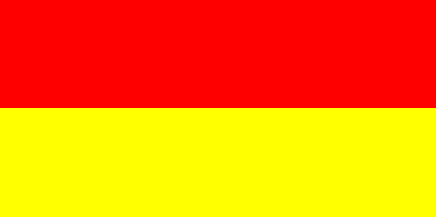 image by Jaume Ollé
image by Jaume Ollé 
Last modified: 2024-08-03 by daniel rentería
Keywords: azuay | cuenca |
Links: FOTW homepage |
search |
disclaimer and copyright |
write us |
mirrors
![]() - indicates
a flag is known..
- indicates
a flag is known..
![]() - indicates it is reported there is no flag.
- indicates it is reported there is no flag.
★ - indicates the cantonal capital
Parishes:
|
|
|
* - indicates an urban parish, which does not have its own government; as such, the cantonal government is in charge of the parish and it is rare for the parish's community to adopt symbols of their own apart from the canton's.
See also:
At www.municipalidadcuenca.gov.ec is the Cuenca flag and arms. I suspect that the city flag,
which is the same as the provincial flag, is also the
cantonal flag.
Jaume Ollé, 17 August 2003
The town of Cuenca, capital of the canton of the same name,
was founded on 12 April 1557. it was registered on the UNESCO
List of World Heritage in 1999.
Translated from www.elmercurio.com.ec.
"The flag of Cuenca is made of two horizontal stripes of 3 x
2 m. The upper stripe is bright red and the lower stripe is
reseda (golden yellow). The two stripes are of equal right.
The red and yellow colours come from the Spanish flag, since
Cuenca has proclaimed itself the forever heir of the virtues of
Spain, Pelayo and the Catholic Kings. The town was granted the
title of "Very Noble and Very Loyal". The writing on it
shield says "Primero Dios y después voz".
A town flag was allowed to be hoisted on houses in relevant
circumstances, either in peace or wartime. The municipal
government required from the Vice-Roy, Marquis of Cañete
[1535-1609; Vicerey of Peru, 1590-1596], the permission to
manufacture its own flag and to fly it publicly in the streets of
the town. The first petitioner was Rodrigo Paz, an inhabitant of
Quito, heading to Cuenca as a special envoy of the government.
The flag provision was received on 10 June 1558 in presence of
the founder, Captain Gil Ramirez Dávalos.
Subsequently, the Procurator of the town, Lorenzo Fernández
Lucero, gave permission to the government to manufacture its own
flag, as granted on 13 February 1576, allowing the purchase of
the required fabric. On 9 May 1590, Procurator Lázaro Vallejo
required again the manufacturing of the flag - the earlier
prescription does not seem to have been applied. The flag was
prescribed as made of crimson fabric with the town's emblems on
one side, and a picture of apostle Santiago, the patron saint of
Spain, on the other side, the flag being bore through the streets
on the eve of the Apostle's Day. The first flag bearer was Mayor
Cristóbal Barzallo Quiroga."
Ivan Sache, 4 October 2008
!.gif) image by António Martins-Tuválkin, 26 April 2016
image by António Martins-Tuválkin, 26 April 2016
It is an oblong flag, depicted as close to 1:2, red with a thick golden
yellow bordure, and charged with five white sugarloaves (of very unusual
shape) set in saltire. This design is, at least, a flagoid of the
municipality or maybe even an actual historical flag.
António Martins-Tuválkin, 26 April 2016
The sugarloaves (I'd never recognize them as such just by viewing) probably
need not be fimbriated black - such lines divide all areas in different colors
in the coat of arms image, so they should either be dropped from the flag image
(heraldically, no sense in separating gules and argent by sable), or added
everywhere - between red field and gold border, and all around the outer edge of
the flag.
Tomislav Todorović, 27 April 2016
I was thinking the same, but decided to go for this hybrid approach (which is
also used in most of our CH subnational banners of arms) because, while it is simple and
straightforward to add a black line along the bordure, it is not clear how
exactly would these strange shapes look like when devoided of their thick,
calligraphic edging. Hopefully we will find out how the actual flag looks like.
António Martins-Tuválkin, 27 April 2016
.gif) image by Paulo García and António Martins-Tuválkin, 26 April 2016
image by Paulo García and António Martins-Tuválkin, 26 April 2016
The coat of arms can be seen in detail
here. It has a samnitic shield placed "au valon" (whose blazoning I leave
for the truely addicted), four-colored manteling in the usual depiction, and a
lance for supporter, bearing a white streamer with the 16th century city motto "Primero
Dios y después voz" (kept till today as a token of militant secularism) and a
flag - that is not a banner of the arms (at least not the same arms as
those on the shield).
António Martins-Tuválkin, 26 April 2016